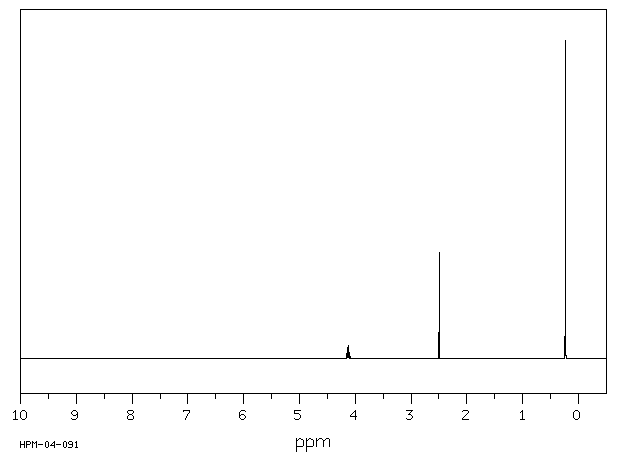Brommethyl-dimethyl-silan | 7393-54-6
中文名称
——
中文别名
——
英文名称
Brommethyl-dimethyl-silan
英文别名
(bromomethyl)dimethylsilane;Dimethyl-brommethyl-silan;Bromomethyl(dimethyl)silane;bromomethyl(dimethyl)silane
CAS
7393-54-6
化学式
C3H9BrSi
mdl
——
分子量
153.094
InChiKey
KBAZIJVUDPZYER-UHFFFAOYSA-N
BEILSTEIN
——
EINECS
——
-
物化性质
-
计算性质
-
ADMET
-
安全信息
-
SDS
-
制备方法与用途
-
上下游信息
-
文献信息
-
表征谱图
-
同类化合物
-
相关功能分类
-
相关结构分类
计算性质
-
辛醇/水分配系数(LogP):1.41
-
重原子数:5
-
可旋转键数:1
-
环数:0.0
-
sp3杂化的碳原子比例:1.0
-
拓扑面积:0
-
氢给体数:0
-
氢受体数:0
安全信息
-
海关编码:2931900090
反应信息
-
作为反应物:参考文献:名称:氯硅烷与(氢甲硅烷基)烷基格氏试剂的反应摘要:氯硅烷被(氢甲硅烷基)甲基,-乙基和-丙基格氏试剂还原。动力学研究表明,还原反应在氯硅烷中是一阶还原反应,在格氏试剂中是二阶还原反应。结论是,对于(氢甲硅烷基)甲基化合物,氢的不稳定性是由于相邻亚甲基的电子给体引起的,而对于(氢甲硅烷基)乙基和-丙基化合物中,亚甲基参与的相邻基团可能在弱化硅氢键方面发挥了一定作用。DOI:10.1016/s0022-328x(00)86606-1
-
作为产物:描述:参考文献:名称:氯硅烷与(氢甲硅烷基)烷基格氏试剂的反应摘要:氯硅烷被(氢甲硅烷基)甲基,-乙基和-丙基格氏试剂还原。动力学研究表明,还原反应在氯硅烷中是一阶还原反应,在格氏试剂中是二阶还原反应。结论是,对于(氢甲硅烷基)甲基化合物,氢的不稳定性是由于相邻亚甲基的电子给体引起的,而对于(氢甲硅烷基)乙基和-丙基化合物中,亚甲基参与的相邻基团可能在弱化硅氢键方面发挥了一定作用。DOI:10.1016/s0022-328x(00)86606-1
文献信息
-
Absolute rate constants for some hydrogen atom abstraction reactions by a primary fluoroalkyl radical in waterElectronic supplementary information (ESI) available: Tables of kinetic data and plots of kinetic data. See http://www.rsc.org/suppdata/ob/b3/b313757k/作者:Li Zhang、Joseph Cradlebaugh、Grzegorz Litwinienko、Bruce E. Smart、Keith U. Ingold、William R. Dolbier, Jr.DOI:10.1039/b313757k日期:——flash photolysis and competitive kinetic methods have been used to measure the absolute bimolecular rate constants for hydrogen atom abstraction in water from a variety of organic substrates including alcohols, ethers, and carboxylic acids by the perfluoroalkyl radical, *CF(2)CF(2)OCF(2)CF(2)SO(3)(-) Na(+). Comparison, where possible, of these rate constants with those previously measured for analogous
-
Hyperconjugative stabilization of silicenium ions: kinetics of hydride abstractions from .beta.-element-substituted silanes作者:Nils Basso、Solvig Goers、Eckhard Popowski、Herbert MayrDOI:10.1021/ja00067a018日期:1993.7Rates of hydride abstractions from j3-silyl-, j3-germyl-, and B-stannyl-substituted silanes (HSiMeZ(CHz- MMe3), M = Si, Ge, Sn) and related compounds by diarylcarbenium ions have been measured. The intermediate silicenium ions, produced in the rate-determining step, are stabilized by hyperconjugation, but the effects are much smaller than in comparable carbenium ions. ~~ ~~ ~~
-
A Stereospecific Access to Allylic Systems Using Rhodium(II)−Vinyl Carbenoid Insertion into Si−H, O−H, and N−H Bonds作者:Priyadarshanie Bulugahapitiya、Yannick Landais、Liliana Parra-Rapado、Denis Planchenault、Valéry WeberDOI:10.1021/jo961952j日期:1997.3.1Rhodium-catalyzed decomposition of alpha-vinyldiazoesters in the presence of silanes, alcohols, ethers, amines, and thiols have been shown to produce the corresponding alpha-silyl, alpha-hydroxy, alpha-alkoxy, alpha-amino, and alpha-thioalkoxy esters in generally good yield with a complete retention of the stereochemistry of the double bond of the diazo precursor. An extension of the process in homochiral series has also been devised using either a chiral auxiliary attached to the ester function or achiral alpha-vinyldiazoesters and Doyle's chiral catalyst Rh-2(MEPY)(4). In the former approach, pantolactone as chiral auxiliary gave diastereoselectivities of up to 70%, while the second approach produced the desired allylsilane with ee as high as 72%. On the other hand, Rh-2(MEPY)(4)-catalyzed insertion into the O-H bond of water led to poor or no enantioselectivity in good agreement with recent literature reports.
-
Danilkina, L. P.; Ostroukhova, O. K., Journal of general chemistry of the USSR, 1989, vol. 59, # 10.2, p. 2061 - 2063作者:Danilkina, L. P.、Ostroukhova, O. K.DOI:——日期:——
-
Popowski, E.; Marekowa, U.; Reiske, T., Zeitschrift fur Anorganische und Allgemeine Chemie作者:Popowski, E.、Marekowa, U.、Reiske, T.、Schulz, H.、Kelling, H.DOI:——日期:——
表征谱图
-
氢谱1HNMR
-
质谱MS
-
碳谱13CNMR
-
红外IR
-
拉曼Raman
-
峰位数据
-
峰位匹配
-
表征信息
同类化合物
黄原酸环癸酯
高纯三甲基锑
顺式-二氯二(环丙胺)铂(II)
顺式-二氯二(乙二胺)氯化铑(1+)
顺式-二(环己基丁氨合)二氯铂(II)
顺式-二(异丙基氨合)二氯铂(II)
顺式-(2-氨基甲基-1-环戊基氨合)二氯铂(II)
顺二氯二羰基铂(II)
顺-二氯双(乙二胺)氯化铱
雷(酸)汞[含水或水加乙醇≥20]
间碳硼烷-9-硫醇
镍,加合(7:2)钪
镉二(二戊基二硫代氨基甲酸盐)
镁,溴-6-庚烯基-
manganese carbide
butyl manganese bromide
锡烷,氯二环己基-
锡四丁醇
锑,(1:1)混合物和钪
锌叔-丁氧化物
锌,溴-1-丙烯基-,(E)-
锇,加合(2:1)钪
锆酸四丁酯
锂丁酯
锂4-异丙氧基-2-甲基-丁烷-2-醇
锂1-丁醇
锂(三氟甲基)乙炔化物
锂(3-氨基丙基)酰胺
铼五羰基碘化物
铼五羰基
银(I)2-羟基乙烷-1-硫醇盐
铯三氯三羰基锇
铬三乙二胺
铬,五羰基(环己胺)-,(OC-6-22)-
铬,二(乙酰腈)二氯-
铝,加合(3:1)钪
铜-乙二胺络合物
铜(II)乙二胺
铜(I)乙炔化物
铍,环戊-1,3-二烯,溴化
铊N,N-二正丁胺
铊,甲氧基二甲基-
铂(2+)二氯化3-甲基丁烷-1,2-二胺(1:1)
铁(3+)三(1-丁醇)
铁(2+)1,1'-(硫烷二基二-1,1-乙二基)二-2,4-环戊二烯化
铀,三甲基-
钾,[三(三甲基甲硅烷基)甲基]-
钴四异硫氰酸酯
钴,乙烷-1,2-二胺
钠辛基二硫代氨基甲酸酯







